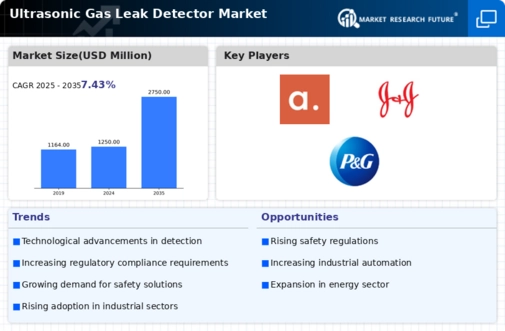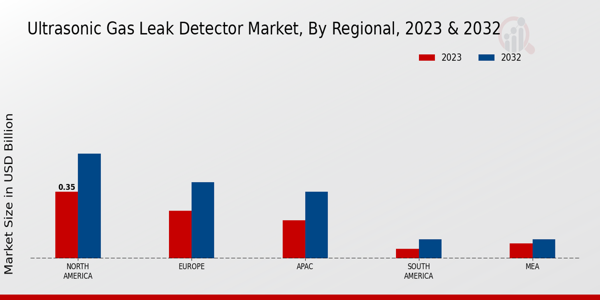Market Growth Projections
The Global Ultrasonic Gas Leak Detector Market Industry is poised for substantial growth, with projections indicating a market value of 1250 USD Million in 2024 and an anticipated increase to 2750 USD Million by 2035. This growth trajectory suggests a compound annual growth rate (CAGR) of 7.43% from 2025 to 2035, reflecting the rising demand for advanced leak detection technologies across various sectors. The market's expansion is likely to be fueled by increasing safety regulations, technological advancements, and a growing emphasis on environmental sustainability.
Technological Advancements
Technological innovations are significantly influencing the Global Ultrasonic Gas Leak Detector Market Industry. The development of sophisticated ultrasonic detection technologies enhances the accuracy and reliability of leak detection systems. These advancements include improved sensor technologies and integration with IoT platforms, allowing for real-time monitoring and data analytics. As industries increasingly adopt smart technologies, the demand for advanced ultrasonic detectors is expected to rise. This trend is reflected in the market's anticipated growth, with projections indicating a value of 2750 USD Million by 2035, showcasing the potential for technological integration in enhancing safety measures.
Increasing Safety Regulations
The Global Ultrasonic Gas Leak Detector Market Industry is experiencing growth driven by stringent safety regulations across various sectors. Governments worldwide are implementing stricter guidelines to ensure workplace safety, particularly in industries such as oil and gas, chemicals, and manufacturing. For instance, regulations from agencies like the Occupational Safety and Health Administration (OSHA) mandate the use of advanced leak detection systems to prevent hazardous incidents. This regulatory environment is likely to propel the demand for ultrasonic gas leak detectors, contributing to the market's projected value of 1250 USD Million in 2024.
Growing Environmental Concerns
Environmental awareness is shaping the Global Ultrasonic Gas Leak Detector Market Industry as companies strive to minimize their ecological footprint. The increasing focus on sustainability and environmental protection is prompting industries to adopt advanced leak detection technologies to prevent gas emissions. Regulatory bodies are also emphasizing the importance of reducing greenhouse gas emissions, further driving the need for effective detection systems. As organizations prioritize environmental compliance, the ultrasonic gas leak detector market is likely to see substantial growth, aligning with global efforts to combat climate change and promote sustainable practices.
Rising Demand in Oil and Gas Sector
The oil and gas sector is a major driver of the Global Ultrasonic Gas Leak Detector Market Industry. With the increasing exploration and production activities, the need for effective leak detection systems has become paramount. Ultrasonic detectors are particularly favored in this sector due to their ability to detect gas leaks from pressurized systems, which can be critical in preventing accidents and environmental damage. As the oil and gas industry continues to expand, the demand for reliable leak detection solutions is projected to grow, contributing to a compound annual growth rate (CAGR) of 7.43% from 2025 to 2035.
Expansion of Industrial Applications
The expansion of industrial applications is a key factor propelling the Global Ultrasonic Gas Leak Detector Market Industry. Various sectors, including pharmaceuticals, food and beverage, and manufacturing, are increasingly recognizing the importance of leak detection systems to ensure operational efficiency and safety. The versatility of ultrasonic detectors makes them suitable for diverse applications, from monitoring gas leaks in production facilities to ensuring safety in storage environments. This broad applicability is expected to drive market growth, as industries seek to enhance their safety protocols and comply with regulatory standards.














Leave a Comment